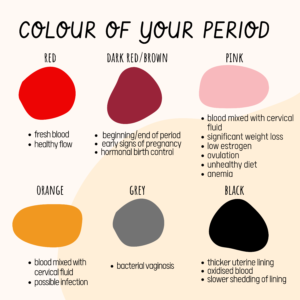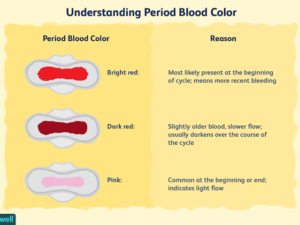Different Period Blood Colours And What It Says About Your Health
The colour of your period or monthly flow can actually tell you if everything is functioning smoothly in your body system or if you’ve got a serious health situation you should focus on.
During menstruation, the body sheds tissue and blood from the uterus through the vagina. This bloody discharge can vary from bright red to dark brown or black depending on how old it is.
Hormonal changes and health conditions can also affect the color and texture of period blood. Different colors of period blood have different significance for your health.
Healthy period blood typically varies from bright red to dark brown or black. Blood or discharge that is orange or grey may indicate an infection.

Here’s a guide to determine what your period colour could mean for your health:
1. Bright Red Blood
This is usually the colour at the start of your cycle. Your uterine lining is shedding, and fast, and usually comes with the painful cramps. In very rare cases, this could also indicate a ruptured ovarian cyst or miscarriage.
After women deliver a baby, they experience bleeding for four to six weeks, which is called lochia. Lochia bleeding begins with a heavy flow and bright red blood. After around day four, lochia may be pinkish or brownish in color.
However, bright red blood is also associated with an infection, such as chlamydia and gonorrhea. These infections can cause bleeding between periods. If you see bright red blood before your period, contact your doctor.
2. Brown or Black Blood
Most common at the very end of your period (light flow or spotting), is when blood has been stored up the longest. Brown discharge of all shades is typically a sign of old blood.
Black or brown is usually old blood, which has had time to oxidize, changing the hue.The blood may also be leftover from your last period.
3. Dark Red Blood
This means your blood has been around inside you for longer. This colour blood appears at the end of your cycle due to high estrogen levels, thick lining and a slower shedding rate, all of which are completely normal.

4. Orange Blood
If there is an orange colour in your menstrual blood, check for these signs to see if it’s a problem. A ‘slippery’ texture is normal but anything else – especially a bad smell, could be a sign that your blood has mixed with cervical fluids, which is usually the indicator of an infection or STD. If you notice this, go straight to your doctor to get it sorted as soon as possible.
5. Pink Blood
If right before your period, you notice light red or pink spotting, this could indicate low estrogen levels. Hormonal issues can lead to other issues later in life (infrequent periods and dryness to name a few).
Some causes of low estrogen include being on hormonal birth control that doesn’t contain estrogen or perimenopause.
If you’re pregnant, a gush of clear or pink fluid from the vagina may be a sign of miscarriage. Other signs including cramping, the passage of tissue, and loss of pregnancy symptoms.The best thing is to quickly see a doctor.
6. Gray Blood
If you see gray or off-white discharge, call your doctor. Gray blood is associated with infections like bacterial vaginosis. Other signs of infection include fever, pain, itching, or a foul odor. If you’re pregnant, a gray discharge may be a sign of miscarriage.

During pregnancy, pink discharge that contains tissue and occurs alongside cramps may indicate a miscarriage. It is important for women who experience vaginal bleeding while pregnant to see their doctor or obstetrician.
Changes in the color of your period blood are not anything to worry about but you should pay attention to your flow volume, changes in cycle length, and pain, or any bleeding that doesn’t have a pattern, as these can indicate underlying conditions.
Period blood can have a metallic smell, like a copper coin. This is typically due to the presence of iron in the blood and is not usually a cause for concern. However, it should not persist much longer after your period ends.
